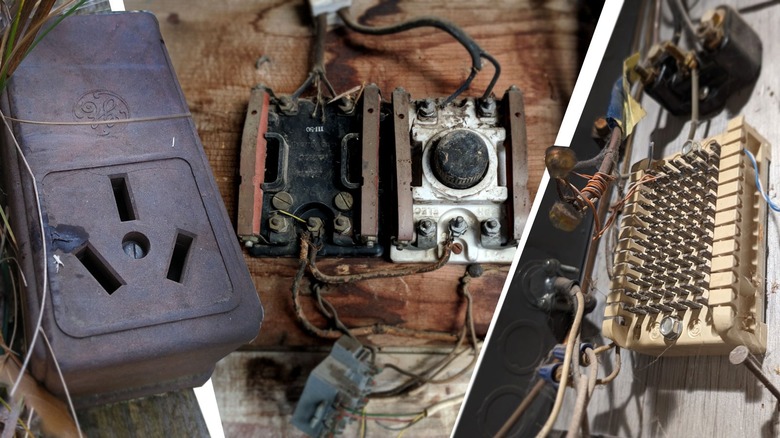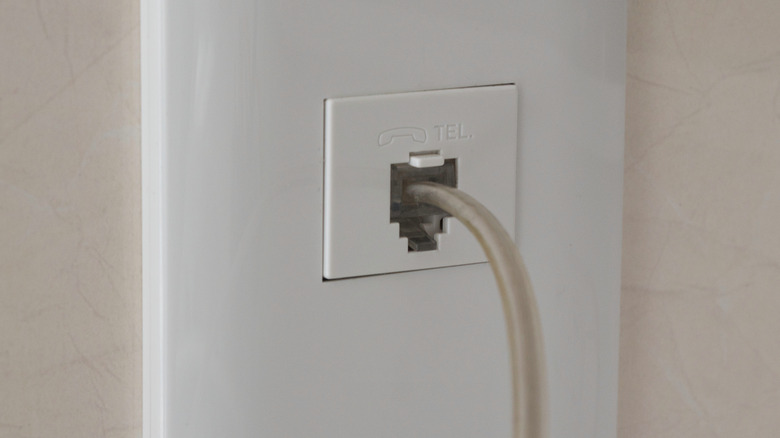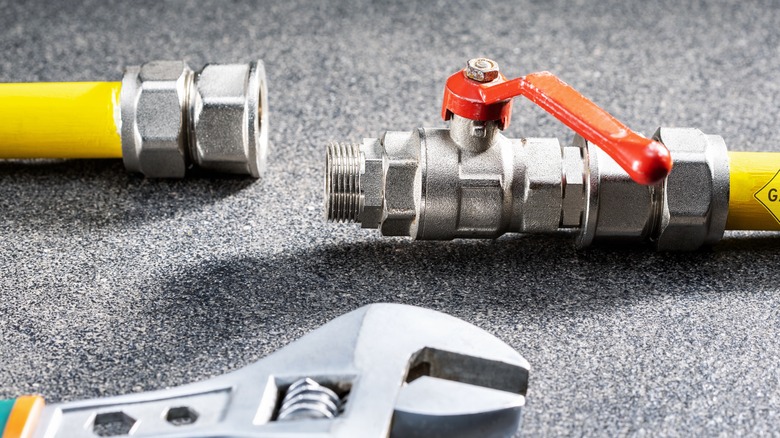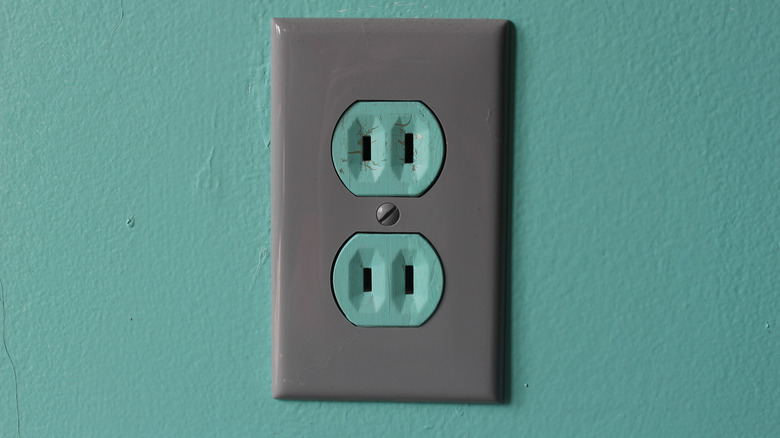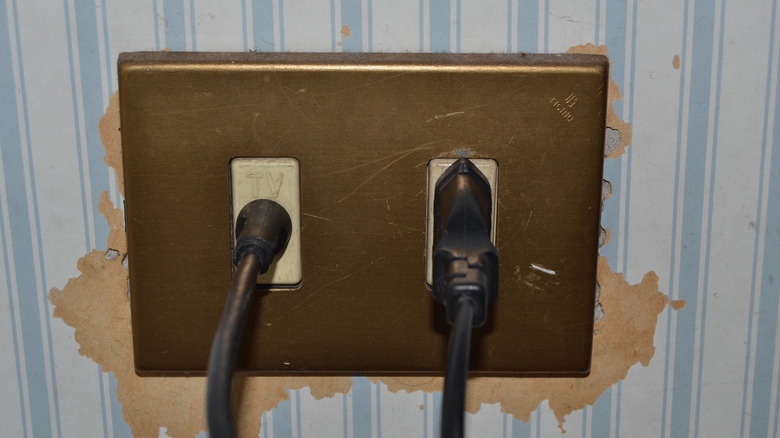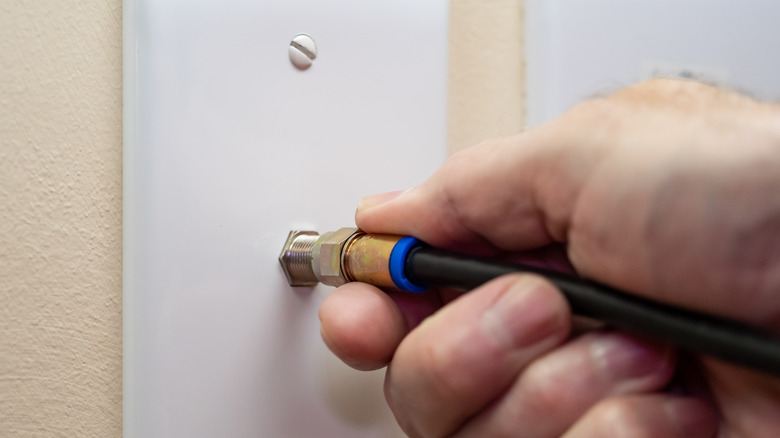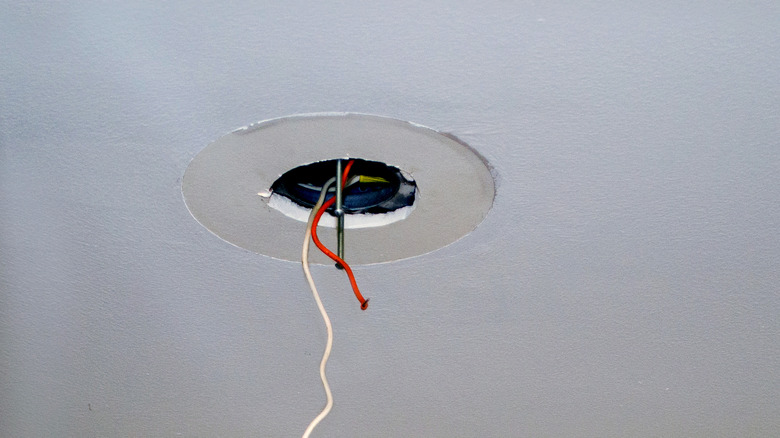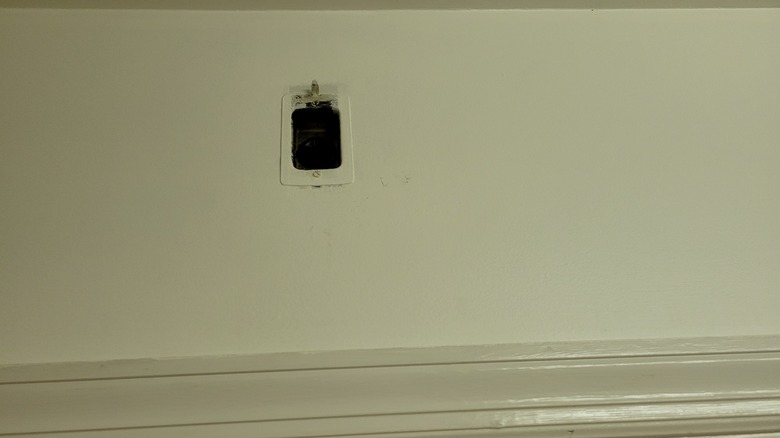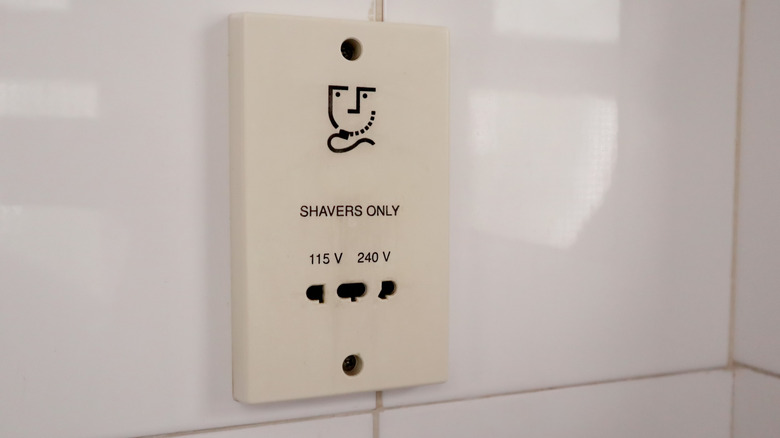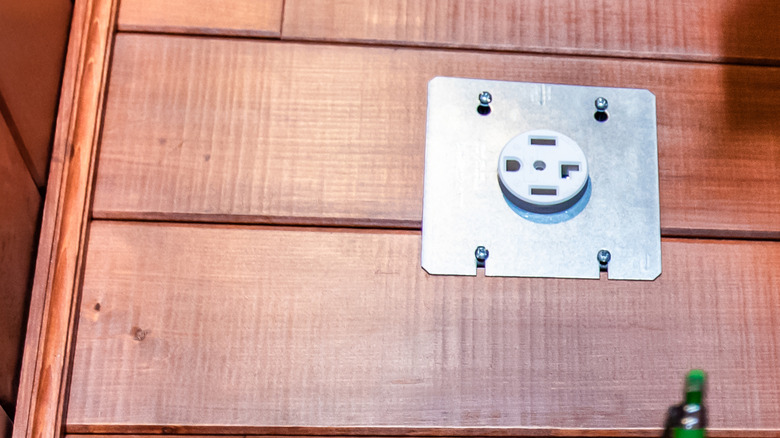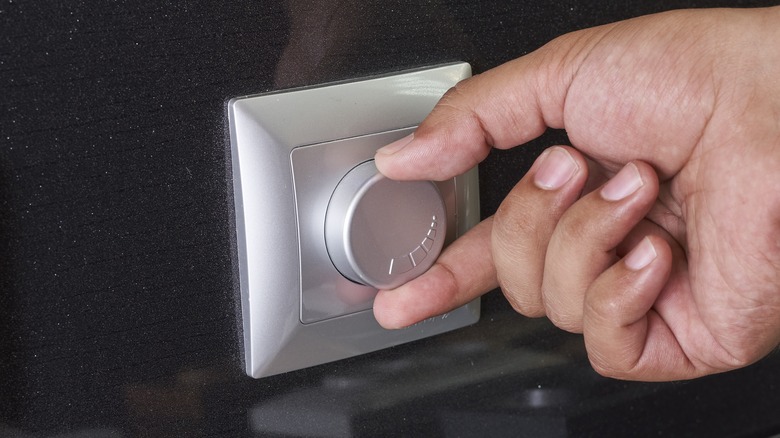Out With The Old: How To Spot And Identify Outdated Technology In Your House Or Apartment
Anyone who is a fan of "what is this thing" style Facebook groups, forums, and subreddits will have seen their fair share of obscure outlets, strange wires, and proprietary plugs. We've compiled a list of some of the more obscure ones, along with some things many of you who still have the screechy dial-up internet noise etched into your soul will recognize — but fresh-faced youngsters who have yet to be crushed by life will not.
It is worth noting that there are connections in your house right now that are seen as a normal, if not essential, part of everyday life. Give it a few years, or more likely a few decades, and younger generations will likely be taking to the internet to inquire what a USB-A port is. Or you might see confused questions about power outlets, as wireless power is totally a thing in the future. Lightswitch? Is that something they used in medieval times to get the torches going? You get the picture.
Still, who needs to wait for the future? In the year 2023, there are plenty of obsolete or obscure outlets to gawp at. Here are a few you may not have heard of.
Old phone jack
While most people will remember using a landline phone, today's teenagers and those younger than them may have grown up in a home that only used cell phones. That doesn't mean they don't know what a landline is, but the exact specifics of it may be lost on them.
As the phone was wired, it had to connect to somewhere. This little socket was called a phone jack, and one will be present in every room of the house that was fitted with a landline phone. There are a couple of kinds of phone jacks. The British had their long four-pin version. Another kind was sort of U-shaped, kind of like a SATA cable's connector if it curled up at both ends instead of just one.
By far, the most common kind sort of looks like a smaller ethernet port. Unfortunately, the connections differ from ethernet, and the wires aren't capable of carrying large amounts of data. So you can't use your home's phone jacks to spread wired internet throughout your home.
Capped gas line
If you notice what appears to be a pipe with a metal cap on the end of it in your kitchen, basement, or living room, you may want to leave it well alone. There's a good chance it's a gas pipe that has been capped off, and tampering with it could have potentially deadly consequences. The pipes can appear anywhere an appliance that used gas is or may have previously been. The list includes stoves, furnaces, fires, and, in extremely old houses, light fittings.
Gas lines are capped for several reasons. Firstly, it's a tight seal and is unlikely to leak. Then there's the fact it's easier than removing all or part of a gas system. It's also easier to reattach an appliance to that bit of line than it would be to reinstall a branch of your house's gas line. As a society, we seem to be moving away from gas as a fuel source, but historically, it was a very common way to generate heat.
If you have other functioning gas appliances in your house, such as a furnace, there will be gas in your system, and tampering with a plugged gas cap might cause a leak. Even if you don't use gas for anything, there's a chance your home wasn't disconnected from the main properly, or the system wasn't purged after a shutoff. Either way, you should treat capped gas pipes as if they're live. If you want to remove the pipe or any other part of your gas system, consult a professional.
Two hole power outlet
If you're in a house with older outlets, you may notice you can't plug power-hungry appliances into some of them. This is because they only have two holes, and appliances over a certain wattage have three prongs. No matter the plug, only two of the prongs carry electricity during normal use. The third prong is a ground wire that can help prevent disaster in the event of a short or some other malfunction. While they're commonplace now, they were rarely seen before the 1970s, and that's when your outlet was likely installed.
Some devices only use two-pronged plugs. These tend to be low-wattage things like cell phone charging bricks, some laptops, and TVs. You can plug any of these into a two-pronged outlet just fine. However, you may also see adapters that will allow three-pronged plugs to be used in a two-pronged outlet. These are a bad idea.
The ground wire only works because the outlet itself is grounded, too. It gives the electricity a safe path to ground, where it won't do any damage. As the third hole on the adapter goes nowhere, the appliance you plug into it will not be grounded. This makes it significantly less safe; those plugs became commonplace for a reason.
It may also be worth considering getting your house rewired if you have several of these outlets. Yes, it's expensive, but if the wiring in your home is over 50 years old, it is far less safe than it could be. Building codes have come a long way since the '70s, at least in regards to wiring. While old systems are often grandfathered into legislation, a rewire will significantly reduce the odds of things like electrical fires.
An antenna socket
If you have some kind of weird outlet in your wall, the chances are it's some kind of antenna socket. These have varying uses and can help transmit or receive signals for everything from TVs to radios to some kind of internet connection. Usually, there are some clues you can use to discern exactly what kind of aerial socket has been installed in your house, but you may have to take to the internet for exact answers.
Signs to watch out for are markings or words on the box's faceplate. If it says TV, that's a pretty good indicator it's some kind of television antenna. Location may also provide clues. Many shortwave and CB radio enthusiasts put their setups in a garage, attic, or basement. So, if there's a weird hookup there, it may be related to something like that.
For the most part, the different connectors do slightly different jobs, and each will be good for a certain transmission frequency. However, this also means some of them are now useless, like this example we found on Reddit. One of the users in the replies points out it can't be used for a modern cable hookup without extensive rewiring. There are also multi-function ports like this confusing-looking example. A user suggests that it has both TV and FM ports on the unit, along with a port that allows you to remotely adjust the antenna for better reception.
An old cable hookup
Not all things that look like antenna sockets are antenna sockets. That little hole in the wall could be similar but entirely different. Cable sockets tend to be threaded, smaller, and rounder, with a plastic core and either a metal pin or piece of copper wire poking out of the center. Or there may not be a socket or box there at all.
Cable hookups can take the form of a seemingly random wire coming through the wall. This could be because there was a box there, but someone yanked it out and just left the wire that took a signal to it dangling in the cavity. Or sometimes the cable was just provided through a long wire. If you find this wire unsightly or think it's getting in the way, they're pretty safe to remove on your own.
It's worth noting that these tend to be coaxial cables and have pretty tough insulation protecting them. So you'll need a good set of wire clippers to snip them off. If you want to do a tidy job of it, you can cut the cable, head to the other side of the wall, and yank what's left of it through. You can then patch the hole and make it look like it was never there in the first place.
Wires/socket for a hard-wired smoke alarm
Notice a hole in your wall with a couple of taped-up wires inside it? If said hole is above a door or otherwise high on the wall, it's likely a void left by an old smoke alarm that was never replaced. Hard-wired smoke alarms have a few benefits. Firstly, they're more reliable as a dead battery is easier to overlook than a power outage. Secondly, those outages aren't likely to affect the alarm as a battery backup is usually installed.
The good news is that it's easy enough to have a replacement installed, so you can benefit from a wired smoke alarm just as your abode's previous occupant did. Unless you're both adept at electrical work and confident enough to do it, you should probably seek professional assistance with this one, though.
A pro can establish that the wires are still live and perform necessary repairs if they aren't. A qualified electrician will also ensure everything is done safely and to code, meaning there's no risk of your new smoke alarm actually causing a fire and no problems that will arise if you choose to sell your house.
Oddly placed plugs for light fittings
A house can't really have enough power outlets. If you've been living somewhere for a while, chances are you've found an obscure spot somewhere you'd like to spend a lot of time in were it not for the lack of a power outlet. To further rub things in, you may have a perfectly good outlet in a seemingly odd location. This may be high above a door, at head height in the middle of a wall, or obscured inside a cupboard.
These plugs don't make much sense these days, but many older dwellings don't have hard-wired lighting in every room. Instead, they'll have somewhere you can plug a lamp or standalone light in, which you would then place on a shelf or dangle from the ceiling. This is also reflected in the way some light switches work in older buildings.
Instead of controlling a light on the ceiling, they will instead control power to one of the room's outlets. This allows you to install a standing light or lamp and easily turn it off or on again. Unfortunately, it can be annoying if a TV or computer is plugged into the outlet's other socket, so the presence of something like this may be one of the things that inspire you to have your house rewired.
Shaving sockets in the bathroom
If you use an electric shaver or beard trimmer, it's probably powered by an internal battery or a couple of disposable AAs. However, this wasn't always the case, and historically, most electric shavers were wired. To make things a little more complex, those shavers also had their own plugs. The existence of shaving plugs is related to safety more than anything. Given the amount of moisture in bathrooms and the fact there's a good chance people will handle the plug with wet hands, there's an increased risk of an electrical shock.
Shaver sockets contain an isolation transformer, which essentially grounds whatever single side someone accidentally touches and renders the plug unable to shock them. So what about the plug's unique look? European shavers use two round prongs, while American shaver sockets tend to have a couple of flat prongs. The reason that they're unique is due to the fact it's a bad idea to plug something that isn't a shaver into them.
The transformers inside the sockets scale down the voltage going into them. A high-draw device like hair curlers or a hairdryer will try to pull more power than the socket's rated for. This will most likely result in you blowing a fuse, but it's not worth messing around with. Lower-power devices such as electric toothbrushes and phone chargers can use a shaver socket without issue.
That 220V hookup in the basement or garage
In the United States, most household items and the outlets supplying them run between 110 and 120 volts, delivered at a frequency of 60Hz. However, for some appliances, this isn't enough. Larger, more demanding appliances like washing machines, dryers, or stoves require a 240-volt hookup, and the plugs for these look a little different from what you may be used to.
The different plug serves a practical purpose as a 220-volt supply will quickly overload electronics that are only rated for 110 volts. That said, most countries outside the U.S. use a 220–240 volt electricity supply. This means products sold both stateside and internationally tend to be rated for use with both standards — and you're less likely to encounter an issue.
If current trends continue, a specialist kind of 220-volt outlet is likely to appear in more and more garages. Level 2 electric vehicle chargers use that voltage, and charging an EV at home makes life an awful lot easier.
Rarely, you may even encounter a 440-volt outlet in something like a garage or workshop. These exist to power highly demanding machinery, such as welding sets or specialist tools. Luckily, 440-volt outlets are very distinctive, and there isn't much danger of someone accidentally plugging a laptop into one.
A dimmer switch
Smart bulbs are pretty handy. Not only do they save you a significant amount of money, but many of them are highly customizable. While not all smart bulbs can produce multiple colors, most can be brightened or dimmed through an app or smart assistant. Believe it or not, this isn't a new feature, and you may have a remnant of the old-school version somewhere in your house.
That remnant is a dimmer switch. It allowed certain types of bulbs to be dimmed or brightened by regulating the amount of electricity passing through them. Despite its name, a dimmer switch isn't really a switch. It's more of a knob that you turn to achieve the desired brightness. If you have a dimmer switch in your house, and it's still connected to a light socket, then you should ensure all of the bulbs you use in said socket are dimmable.
You should also be aware of the maximum voltage the socket can take. While, technically, you can run a bulb too powerful for the socket by simply keeping the dimmer set low, this is probably a bad idea. If you forget the bulb is a bit too much, or someone who doesn't know turns on the light, you could easily overload the socket.
Dimmer switches have been around for decades. So, while Alexa and other home assistants are great in many ways, one of their most popular functions isn't exactly unique.
